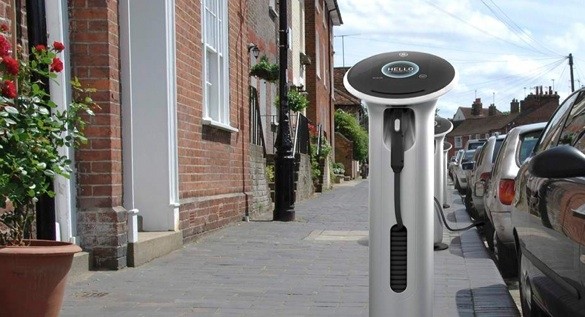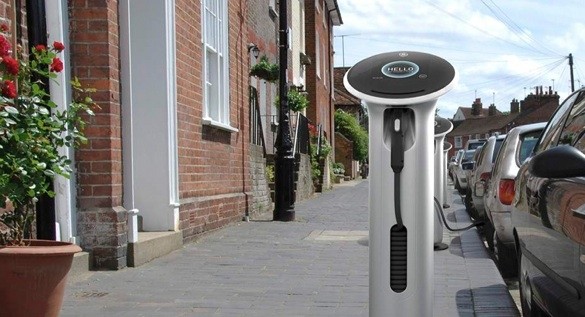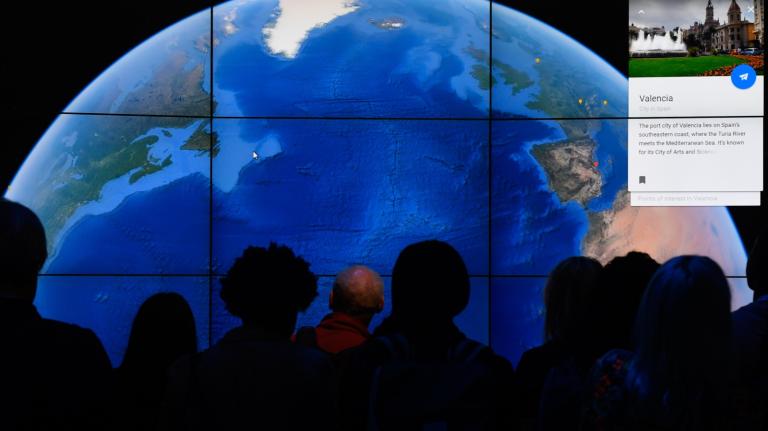 GE’s stylish WattStation electric car charging station.Photo: GE
GE’s stylish WattStation electric car charging station.Photo: GE
Jeff Immelt, chief executive of General Electric, flew into San Francisco to announce on Tuesday that GE was hooking up with prominent venture capital firms from Silicon Valley, the East Coast, and Europe to offer a supersized version of the X Prize for smart grid innovation. (GE and the participating venture capitalists are each contributing $100 million to the challenge.)
“We really believe this digital energy space is going to move fast and big as an economic proposition,” Immelt said before a hundred or so of Silicon Valley’s green tech elite who gathered for a lavish press event at the neo-classical Bently Reserve building in downtown San Francisco. “It also lays the groundwork for everything that needs to be done in an energy future, from nuclear to renewables.”
“GE can offer 50 to 60 percent of the solutions,” he added. “But the only way we can grow is by partnering with the venture community.”
And you too, Grist reader. GE will essentially crowdsource ideas, business plans, and potential startup acquisitions at a new site called Ecomagination Challenge: Powering the Grid. (“Ecomagination” is how GE brands its various environmental and green technology ventures and initiatives.)
Between now and September 30 you can submit ideas and vote on the best ones — the one scoring the most reader votes, and GE’s approval, wins $50,000. The company and its venture partners will award five other entries $100,000 each, which could lead to further equity investment.
A day into the smart grid challenge, ideas submitted from around the world range from wind farms on the Great Lakes to a proposal to “harness the energy from the Earth’s rotation.”
Now it’s doubtful that any startup entrepreneur worth her seed funding will risk floating a potential multimillion-dollar idea for all to see. But GE’s partnership with venture capital firms such as Kleiner Perkins Caufield & Byers and Rockport Capital Partners — not to mention its use of social media to troll for innovative ideas — speaks to the challenges of building a smart grid.
First we need to define what a smart grid is. Comparing it to the Internet is a favored analogy. The current power transmission system is patchwork of early-to-mid 20th century technology that sends electricity from power plants to homes, offices, and factories. It’s essentially a one-way, analog system.
What Immelt calls “digital energy” will transform the power grid into a two-way, interactive system through the use of software, sensors, and other devices that allow utilities and grid operators to control and monitor energy use from the household level up, as well as get real-time data on electricity demand and supply. The various parts of the grid — transformers, substations, power lines — will communicate digitally, alerting operators, for instance, when a component has failed.
The ability to collect and analyze such grid data is crucial for the mass expansion of renewable energy. Most forms of green energy — solar and wind, for instance — are intermittent and increasingly decentralized; there are more than 31,000 rooftop solar installations in California alone.
To maximize renewable energy production and minimize greenhouse gas emissions, utilities and grid operators must be able to balance electricity being fed into the grid from tens of thousands of such sources along with energy from centralized fossil fuel power stations.
And in the coming years, utilities will need to know the location and charging status of tens of thousands of electric cars, each one automobile battery both a consumer and a potential provider of electricity. (If 100,000 cars plug in at 9 p.m. in California just as wind farms hit peak production, a utility will want to use that emission-free electricity to charge up emission-free vehicles rather than rely on, say, natural gas-fired power plants.)
That also means giving consumers data about their electricity use so they can manage their own personal grid to reduce and balance their energy consumption.
The Internet analogy only goes so far, however. Digitalizing the grid is infinitely more complicated than building and commercializing the Net. The power grid is controlled and owned by thousands of utilities and operators, subject to state and federal regulation.
“We didn’t deal with the regulatory context that the smart grid has to,” Paul Koontz, a partner with Foundation Capital, said at the Tuesday event, referring to the early days of the Internet. “We had a little more latitude to do things on the hairy edge. The Internet wasn’t considered mission critical back then.”
Chuck McDermott of RockPort Capital likened the jumble of old technologies layered on top of the aging power grid to “a 100-year-old hairball that we’ll have to unwind over a period of time.”
Immelt estimated that detangling that hairball is at least a $15 billion business opportunity.
Kleiner Perkins’ Ray Lane said creating technologies to improve the efficiency of the grid is not the challenge. The challenge is scaling those technologies across a patchwork of transmission systems.
“This is a slow fat rabbit,” said Lane about the current power grid. “You could apply elementary technology to this and reap benefits.”
But for all the talk Tuesday of cooperation between the East Coast-based global behemoth and the fast-moving venture capitalists of Silicon Valley, it’s clear that GE also poses an immense competitive threat to many of the green tech startups those VCs have been nurturing with their cash and expertise.
Immelt made clear that GE has gone green for the green.
“If we had to do it over again, we wouldn’t use the word green,” he said, referring to Ecomagination. “What it’s about is industrialization, commerce, and profit.”
He estimated that if GE’s 92 Ecomagination products — with 30 more to come later this year — were collected into a standalone business it would rank No. 130 in the Fortune 500.
On display Tuesday in galleries surrounding the atrium where Immelt spoke were dozens of green GE products, from a wind turbine to two of the company’s newest offerings, a gadget called Nucleus that monitors your home electricity use and an electric car charger called WattStation.
Both devices should send shivers throughout Silicon Valley as they compete with products and services being developed by a host of startups.
The WattStation is a sleek colorful pedestal that looks like it could have sprung from Steve Job’s imagination and is designed for city streets. (A mockup was placed outside the Bently Reserve alongside a Nissan Leaf electric car.)
“We wanted it to be more like greenery in the city rather than a large piece of infrastructure,” said Yves Behar, the noted designer who created the device’s look.
Needless to say, the WattStation is smart grid ready.



